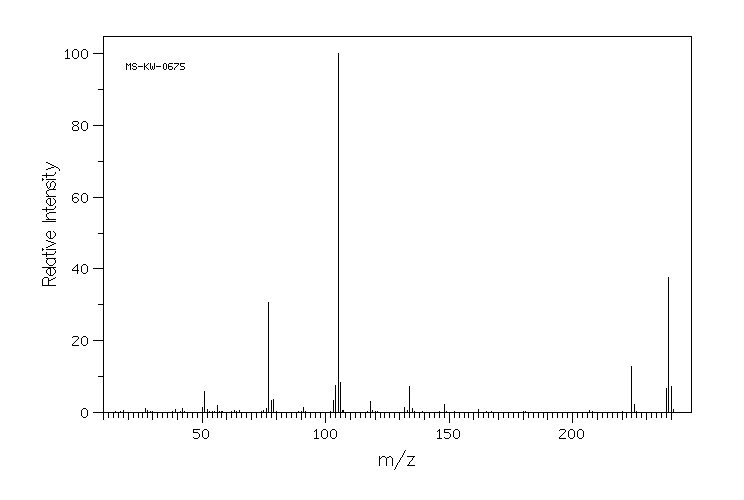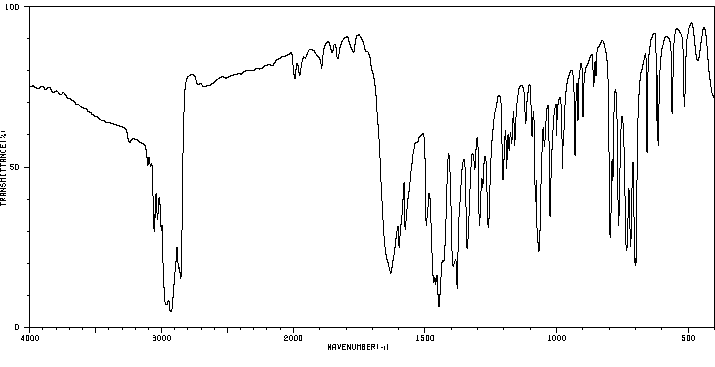N-(α-methylbenzyl)-N-methylbenzamid | 69048-30-2
中文名称
——
中文别名
——
英文名称
N-(α-methylbenzyl)-N-methylbenzamid
英文别名
N-methyl-N-(1-phenylethyl)benzamide;N-Methyl-N-(α-phenylethyl)-benzamid
CAS
69048-30-2;32494-39-6
化学式
C16H17NO
mdl
MFCD21366918
分子量
239.317
InChiKey
ZKAHIXVKNJRTFV-UHFFFAOYSA-N
BEILSTEIN
——
EINECS
——
-
物化性质
-
计算性质
-
ADMET
-
安全信息
-
SDS
-
制备方法与用途
-
上下游信息
-
文献信息
-
表征谱图
-
同类化合物
-
相关功能分类
-
相关结构分类
物化性质
-
沸点:386.6±21.0 °C(Predicted)
-
密度:1.074±0.06 g/cm3(Predicted)
计算性质
-
辛醇/水分配系数(LogP):3.3
-
重原子数:18
-
可旋转键数:3
-
环数:2.0
-
sp3杂化的碳原子比例:0.187
-
拓扑面积:20.3
-
氢给体数:0
-
氢受体数:1
上下游信息
-
下游产品
中文名称 英文名称 CAS号 化学式 分子量 N-(1-苯基乙基)苯甲酰胺 N-(1-phenylethyl)benzamide 3480-59-9 C15H15NO 225.29
反应信息
-
作为反应物:参考文献:名称:惰性酰胺羰基的直接化学选择性烯丙基化摘要:利用Schwartz试剂将惰性酰胺羰基直接烯丙基化,得到取代的叔胺或仲胺。成功避免了预活化步骤,这通常是增加酰胺亲电性的必要条件。该反应显示出显着的官能团耐受性,并且甚至在存在甲基酯和硝基的情况下也进行。DOI:10.1021/ol3000316
-
作为产物:描述:N-Methyl-N-(1-phenylethenyl)benzamide 在 氧气 、 一水合肼 、 7-(trifluoromethyl)-1,10-ethyleneisoalloxazinium chloride 作用下, 以 水 为溶剂, 100.0 ℃ 、101.33 kPa 条件下, 反应 18.0h, 生成 N-(α-methylbenzyl)-N-methylbenzamid参考文献:名称:水中酰胺的有机催化二酰亚胺还原。摘要:桥接的黄酮有机催化剂在二酰亚胺介导的水性条件下的酰胺还原中显示出功效。这代表了富电子烯烃的第一次二酰亚胺还原,并为使用烷基化剂进行N-烷基化提供了一种清洁的替代方法。DOI:10.1039/c0cc02272a
文献信息
-
Chemical and microsomal oxidation of tertiary amides: regio- and stereoselective aspects作者:Jim Iley、Roberto Tolando、Luis ConstantinoDOI:10.1039/b102731j日期:——TPPFe/ButOOH reaction ring oxidation is preferred to N-demethylation, paralleling the relative stabilities of the corresponding intermediate carbon-centred radicals as calculated by the AM1 semi-empirical method. In contrast, the microsomal reaction of the N-methyllactams strongly favours N-demethylation, demonstrating that hydrogen atom abstraction from the alkyl group Z to the amide carbonyl oxygen atom is preferred构象受限 叔酰胺 N-甲基-2-吡咯烷酮 在图6中,N-甲基-2-哌啶酮7和N-甲基-ε-己内酰胺8被5,10,15,20-四苯基卟啉toiron(III)氯化物/氧化。叔丁基过氧化氢(TPPFe / Bu t OOH)和苯巴比妥诱导的大鼠肝微粒体。产物是N-去甲基化的内酰胺类以及类似的N-甲基酰亚胺和诺里米德。对于TPPFe / Bu t OOH反应环氧化作用与N-脱甲基化相比,“亚甲基”是优选的,其平行于通过AM1半经验方法计算的相应的以碳为中心的中间自由基的相对稳定性。相比之下,N-甲基内酰胺类的微粒体反应强烈促进N-脱甲基化,这表明从H-甲基内酰胺中提取氢原子烷基 Z到酰胺 羰氧原子是优选的。手性叔酰胺 N-甲基-N-(1-苯乙基)苯甲酰胺 9和N-甲基-5-苯基-2-吡咯烷酮 10也通过TPPFe /卜氧化吨OOH和由苯巴比妥诱导的大鼠肝微粒体。使用TPPPe / Bu t OOH,优选9的仲烷基的损失约为1倍。6
-
Von der basenkatalysierten Ring�ffnung von 2H-Azirinen zu einer ?-Alkylierungsmethode von prim�ren Aminen作者:Adrian Heinz Schulthess、Hans-J�rgen HansenDOI:10.1002/hlca.19810640509日期:1981.7.22From a Base Catalyzed Ring Opening of 2H-Azirines to an α-Alkylation Method of Primary Amines从2 H-嗪的碱催化开环到伯胺的α-烷基化方法
-
Huisgen,R. et al., Chemische Berichte, 1971, vol. 104, p. 1532 - 1549作者:Huisgen,R. et al.DOI:——日期:——
-
US7241759B2申请人:——公开号:US7241759B2公开(公告)日:2007-07-10
表征谱图
-
氢谱1HNMR
-
质谱MS
-
碳谱13CNMR
-
红外IR
-
拉曼Raman
-
峰位数据
-
峰位匹配
-
表征信息
同类化合物
(βS)-β-氨基-4-(4-羟基苯氧基)-3,5-二碘苯甲丙醇
(S,S)-邻甲苯基-DIPAMP
(S)-(-)-7'-〔4(S)-(苄基)恶唑-2-基]-7-二(3,5-二-叔丁基苯基)膦基-2,2',3,3'-四氢-1,1-螺二氢茚
(S)-盐酸沙丁胺醇
(S)-3-(叔丁基)-4-(2,6-二甲氧基苯基)-2,3-二氢苯并[d][1,3]氧磷杂环戊二烯
(S)-2,2'-双[双(3,5-三氟甲基苯基)膦基]-4,4',6,6'-四甲氧基联苯
(S)-1-[3,5-双(三氟甲基)苯基]-3-[1-(二甲基氨基)-3-甲基丁烷-2-基]硫脲
(R)富马酸托特罗定
(R)-(-)-盐酸尼古地平
(R)-(-)-4,12-双(二苯基膦基)[2.2]对环芳烷(1,5环辛二烯)铑(I)四氟硼酸盐
(R)-(+)-7-双(3,5-二叔丁基苯基)膦基7''-[((6-甲基吡啶-2-基甲基)氨基]-2,2'',3,3''-四氢-1,1''-螺双茚满
(R)-(+)-7-双(3,5-二叔丁基苯基)膦基7''-[(4-叔丁基吡啶-2-基甲基)氨基]-2,2'',3,3''-四氢-1,1''-螺双茚满
(R)-(+)-7-双(3,5-二叔丁基苯基)膦基7''-[(3-甲基吡啶-2-基甲基)氨基]-2,2'',3,3''-四氢-1,1''-螺双茚满
(R)-(+)-4,7-双(3,5-二-叔丁基苯基)膦基-7“-[(吡啶-2-基甲基)氨基]-2,2”,3,3'-四氢1,1'-螺二茚满
(R)-3-(叔丁基)-4-(2,6-二苯氧基苯基)-2,3-二氢苯并[d][1,3]氧杂磷杂环戊烯
(R)-2-[((二苯基膦基)甲基]吡咯烷
(R)-1-[3,5-双(三氟甲基)苯基]-3-[1-(二甲基氨基)-3-甲基丁烷-2-基]硫脲
(N-(4-甲氧基苯基)-N-甲基-3-(1-哌啶基)丙-2-烯酰胺)
(5-溴-2-羟基苯基)-4-氯苯甲酮
(5-溴-2-氯苯基)(4-羟基苯基)甲酮
(5-氧代-3-苯基-2,5-二氢-1,2,3,4-oxatriazol-3-鎓)
(4S,5R)-4-甲基-5-苯基-1,2,3-氧代噻唑烷-2,2-二氧化物-3-羧酸叔丁酯
(4S,4''S)-2,2''-亚环戊基双[4,5-二氢-4-(苯甲基)恶唑]
(4-溴苯基)-[2-氟-4-[6-[甲基(丙-2-烯基)氨基]己氧基]苯基]甲酮
(4-丁氧基苯甲基)三苯基溴化磷
(3aR,8aR)-(-)-4,4,8,8-四(3,5-二甲基苯基)四氢-2,2-二甲基-6-苯基-1,3-二氧戊环[4,5-e]二恶唑磷
(3aR,6aS)-5-氧代六氢环戊基[c]吡咯-2(1H)-羧酸酯
(2Z)-3-[[(4-氯苯基)氨基]-2-氰基丙烯酸乙酯
(2S,3S,5S)-5-(叔丁氧基甲酰氨基)-2-(N-5-噻唑基-甲氧羰基)氨基-1,6-二苯基-3-羟基己烷
(2S,2''S,3S,3''S)-3,3''-二叔丁基-4,4''-双(2,6-二甲氧基苯基)-2,2'',3,3''-四氢-2,2''-联苯并[d][1,3]氧杂磷杂戊环
(2S)-(-)-2-{[[[[3,5-双(氟代甲基)苯基]氨基]硫代甲基]氨基}-N-(二苯基甲基)-N,3,3-三甲基丁酰胺
(2S)-2-[[[[[((1S,2S)-2-氨基环己基]氨基]硫代甲基]氨基]-N-(二苯甲基)-N,3,3-三甲基丁酰胺
(2S)-2-[[[[[[((1R,2R)-2-氨基环己基]氨基]硫代甲基]氨基]-N-(二苯甲基)-N,3,3-三甲基丁酰胺
(2-硝基苯基)磷酸三酰胺
(2,6-二氯苯基)乙酰氯
(2,3-二甲氧基-5-甲基苯基)硼酸
(1S,2S,3S,5S)-5-叠氮基-3-(苯基甲氧基)-2-[(苯基甲氧基)甲基]环戊醇
(1S,2S,3R,5R)-2-(苄氧基)甲基-6-氧杂双环[3.1.0]己-3-醇
(1-(4-氟苯基)环丙基)甲胺盐酸盐
(1-(3-溴苯基)环丁基)甲胺盐酸盐
(1-(2-氯苯基)环丁基)甲胺盐酸盐
(1-(2-氟苯基)环丙基)甲胺盐酸盐
(1-(2,6-二氟苯基)环丙基)甲胺盐酸盐
(-)-去甲基西布曲明
龙蒿油
龙胆酸钠
龙胆酸叔丁酯
龙胆酸
龙胆紫-d6
龙胆紫








